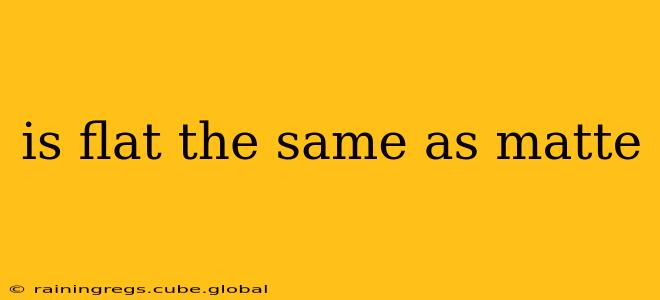The terms "flat" and "matte" are often used interchangeably, especially in the context of paint, but there are subtle differences. While both describe a lack of shine or gloss, they represent slightly different levels of sheen and visual texture. Understanding these nuances can significantly impact your choices in various applications, from interior design to photography.
What is a Flat Finish?
A flat finish, also known as a dead flat or zero-sheen finish, possesses the lowest level of gloss. It reflects almost no light, resulting in a completely non-reflective surface. This characteristic makes it excellent for hiding imperfections in walls, but it can also be more challenging to clean. Flat paints are typically chosen for their ability to create a soft, muted appearance, ideal for creating a calm and serene atmosphere in a room.
What is a Matte Finish?
A matte finish has a slightly higher sheen than a flat finish. While still relatively low in gloss, it possesses a subtle, velvety appearance. It’s not completely non-reflective but reflects light minimally, creating a softer look than a satin or gloss finish. Matte finishes are more durable and easier to clean than flat finishes, making them a popular choice for areas that require more frequent cleaning, such as kitchen walls or high-traffic areas.
Key Differences Between Flat and Matte Finishes:
The primary difference lies in the degree of sheen. Flat finishes are completely devoid of shine, while matte finishes have a very low, almost imperceptible level of sheen. This subtle difference is often difficult to discern with the naked eye, particularly in low light.
Think of it this way:
- Flat: Imagine the surface of a piece of unbleached cotton fabric. Completely devoid of shine.
- Matte: Imagine the surface of a smooth, velvety stone. A barely perceptible softness, a subtle hint of reflected light.
This minor difference in reflectivity directly impacts durability and cleanability. Matte finishes are generally more durable and easier to clean than flat finishes because the slight sheen makes it more resistant to staining and easier to wipe clean.
What About Other Finishes? How Do Flat and Matte Compare?
To further clarify, let's compare flat and matte to other common finishes:
- Eggshell: A slightly higher sheen than matte, offering slightly better durability and cleanability.
- Satin: A moderate sheen that is more durable and easier to clean than matte or flat finishes.
- Semi-Gloss: A higher sheen than satin, ideal for high-moisture areas like bathrooms and kitchens due to its superior durability and cleanability.
- High-Gloss: The highest sheen, offering exceptional durability but highlighting imperfections more prominently.
Which Finish Should I Choose?
The best choice between flat and matte—or any other finish—depends on the specific application and desired aesthetic. Consider these factors:
- Location: Flat finishes are ideal for low-traffic areas where hiding imperfections is paramount. Matte finishes are more suitable for areas requiring slightly more durability and cleanability.
- Aesthetic: Flat finishes offer a softer, more muted appearance, while matte finishes provide a slightly more refined look.
- Durability and Cleanability: Matte finishes are more durable and easier to clean than flat finishes.
Ultimately, the differences between flat and matte can be subtle, and in many cases, the terms are used interchangeably. However, understanding these subtle differences will help you make the best choice for your specific needs. When in doubt, consult with a paint professional or refer to the manufacturer's specifications for precise definitions and recommendations.
